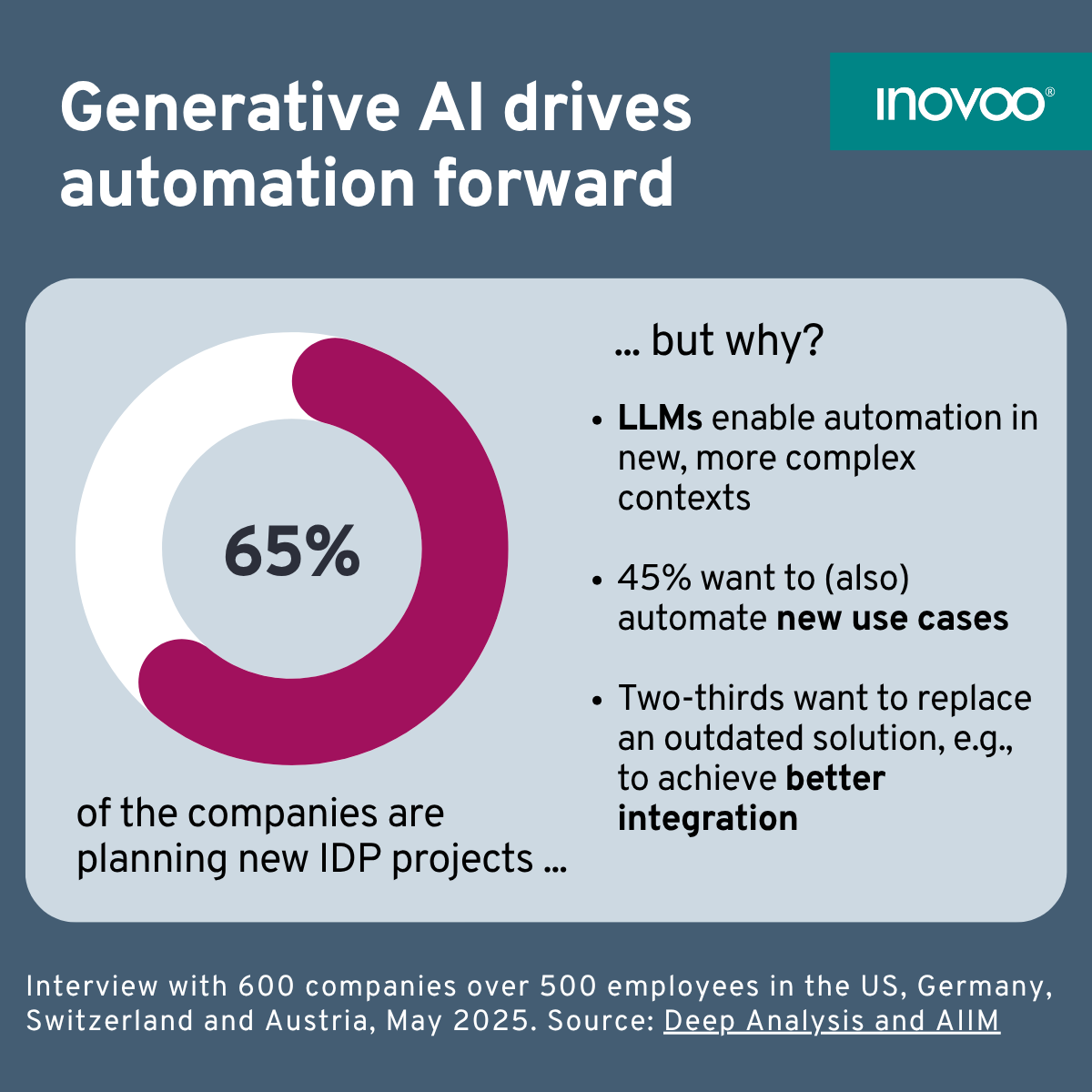How Intelligent Document Processing Is Evolving
Intelligent document processing (IDP) has evolved significantly in recent years: Companies today are faced with rising customer expectations and, at the same time, many new opportunities created by AI technologies. Current figures show that many organizations are looking for new, better solutions for their processes or even want to automate completely new document workflows. In this blog article, you can find out what developments lie beneath this trend and why leading companies are realigning their document processing right now.
Go straight to:
- How Intelligent Document Processing Is Evolving
- Why is effective document processing important?
- How is intelligent document processing changing at the moment?
- What are the benefits of switching to a new solution?
- Solutions by inovoo make the migration easy
- Conclusion: Switch now, benefit for years to come
What is Intelligent Document Processing?
Intelligent document processing (IDP) is a technology that uses artificial intelligence (AI) to automatically extract data from documents, process it, and integrate it into digital business processes.
Unlike traditional methods, IDP recognizes the context of information in unstructured documents. Technologies such as machine learning (ML) and natural language processing (NLP) enable data to be processed faster and with higher quality.
Why is effective document processing important?
Most companies receive large volumes of different documents, which can be time-consuming and resource-intensive to process. An additional challenge is that documents often arrive via a wide variety of channels, such as email, letter, or online form. Numerous document processes are now largely automated, which means a significant gain in efficiency compared to manual processing. However, every process has its weaknesses – even if it has already been digitized and IDP software is used. Automation rates that were impressive a few years ago are now taken for granted. Process solutions that are inflexible and do not fully exploit the potential of new technological developments can threaten the competitiveness of companies. This is particularly true in industries with high customer expectations.
How is intelligent document processing changing at the moment?
In a recent study, IDP analyst Deep Analysis, in collaboration with AIIM, investigated the document processing strategies currently being pursued by large companies in Germany, Austria, Switzerland, and the US. The results reveal the changes that are currently taking place:
- Almost two-thirds of companies (65%) are currently planning new IDP projects
- Slightly less than half also plan to automate new processes, 55% want to focus exclusively on existing use cases
- At the same time, 66% of companies aim to replace an existing solution that is no longer satisfactory.
But how can these figures be interpreted?
One key driver is the new possibilities offered by artificial intelligence: processes that were previously too complex for complete automation can now be mapped efficiently. These could be documents that do not have a uniform structure, contain a lot of complex information, and could therefore only be automated after lengthy training processes.
LLMs make automation much easier in such cases: thanks to their context-based understanding, they can analyze and read almost any document. It is therefore easy to understand why companies want to exploit this new potential and automate these new use cases.
What is surprising, however, is the large number of companies that are focusing on existing use cases, at least at first glance. In many cases, this seems to involve processes where an existing IDP solution is to be replaced. But how can this willingness to migrate be explained? What are the potential benefits for companies switching to a new solution?
What are the benefits of switching to a new solution?
There are various reasons for moving away from existing systems: in some cases, software providers discontinue certain solutions, making a change unavoidable. More often, however, companies are dissatisfied with the performance, flexibility, or integration capabilities of legacy systems. Another factor may be the excessive complexity of operating and maintaining the system, which requires expensive maintenance contracts and leads to dependence on the software provider.
One particularly relevant issue at the moment is the integration of generative AI: for companies to exploit the full potential of this technology, large language models (LLMs) must be seamlessly and securely integrated into existing processing workflows. In many cases, however, this is not possible with the systems currently in use. New AI technologies can then only be used via additional, external solutions – which can ruin the promised efficiency gains.
Therefore, new solutions are needed that are future-proof, can be operated by the department itself, and make the use of AI language models as easy as possible. This way, companies want to modernize their document processing and become more independent and flexible. The goal is to optimize costs and resources while taking advantage of the new opportunities offered by AI – in other words, doing intelligent document processing right.
Solutions by inovoo make the migration easy
The document and process solutions by inovoo have been continuously developed and supplemented with the latest technologies for over 20 years. For you as a customer, this means that all processes can be adapted to changing requirements or increased input volumes at any time. This is made possible by the intuitive low-code platform NOVO CxP, designed for users without expert IT knowledge.
To keep processes efficient, different technologies should be able to be combined flexibly. With NOVO AI Studio, you can bring the power of modern LLMs directly into your workflows. However, many processes can be easily automated even without resource-intensive AI. That's why inovoo relies on NOVO CxP and NOVO AI Studio, a clever combination of AI and established methods of IDP and BPM, for maximum automation and efficiency.
Switching to inovoo is a simple three-step process:
- In a free initial consultation, you discuss your requirements with our experts and find out exactly how the transition will work for your processes.
- Our team creates a proof of concept with all the details.
- Now it's time to implement and integrate the solution into your existing system landscape. We migrate your existing processes and data and support you every step of the way.
Your benefits with inovoo
✅ Create your own workflows
✅ All input channels in one platform
✅ Seamless connection to target systems
The result: your processes are over 90% automated via a future-proof and efficient system. After the smooth migration process, you will see the first results after just a few weeks.
Conclusion: Switch now, benefit for years to come
Intelligent document processing is changing, and it is happening for a good reason. Many companies want to replace inefficient legacy systems in order to benefit from new technologies and greater flexibility. With NOVO CxP and NOVO AI Studio, inovoo offers exactly that – and makes the transition easier than ever. Companies that act now will make their processes fit for the future and secure clear competitive advantages.


